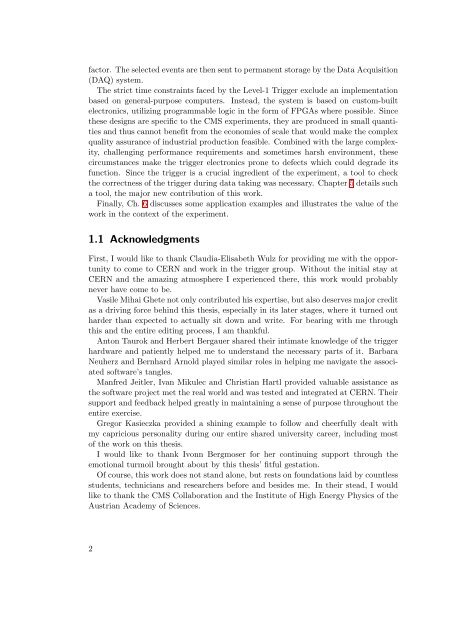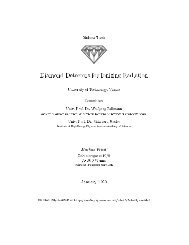You also want an ePaper? Increase the reach of your titles
YUMPU automatically turns print PDFs into web optimized ePapers that Google loves.
factor. The selected events are then sent to permanent storage by the Data Acquisition(DAQ) system.The strict time constraints faced by the Level-1 Trigger exclude an implementationbased on general-purpose computers. Instead, the system is based on custom-builtelectronics, utilizing programmable logic in the form of FPGAs where possible. Sincethese designs are specific to the CMS experiments, they are produced in small quantitiesand thus cannot benefit from the economies of scale that would make the complexquality assurance of industrial production feasible. Combined with the large complexity,challenging performance requirements and sometimes harsh environment, thesecircumstances make the trigger electronics prone to defects which could degrade itsfunction. Since the trigger is a crucial ingredient of the experiment, a tool to checkthe correctness of the trigger during data taking was necessary. Chapter 5 details sucha tool, the major new contribution of this work.Finally, Ch. 6 discusses some application examples and illustrates the value of thework in the context of the experiment.1.1 AcknowledgmentsFirst, I would like to thank Claudia-Elisabeth Wulz for providing me with the opportunityto come to CERN and work in the trigger group. Without the initial stay atCERN and the amazing atmosphere I experienced there, this work would probablynever have come to be.Vasile Mihai Ghete not only contributed his expertise, but also deserves major creditas a driving force behind this thesis, especially in its later stages, where it turned outharder than expected to actually sit down and write. For bearing with me throughthis and the entire editing process, I am thankful.Anton Taurok and Herbert Bergauer shared their intimate knowledge of the triggerhardware and patiently helped me to understand the necessary parts of it. BarbaraNeuherz and Bernhard Arnold played similar roles in helping me navigate the associatedsoftware’s tangles.Manfred Jeitler, Ivan Mikulec and Christian Hartl provided valuable assistance asthe software project met the real world and was tested and integrated at CERN. Theirsupport and feedback helped greatly in maintaining a sense of purpose throughout theentire exercise.Gregor Kasieczka provided a shining example to follow and cheerfully dealt withmy capricious personality during our entire shared university career, including mostof the work on this thesis.I would like to thank Ivonn Bergmoser for her continuing support through theemotional turmoil brought about by this thesis’ fitful gestation.Of course, this work does not stand alone, but rests on foundations laid by countlessstudents, technicians and researchers before and besides me. In their stead, I wouldlike to thank the CMS Collaboration and the Institute of High Energy Physics of theAustrian Academy of Sciences.2












